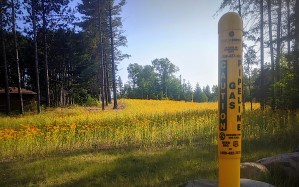
This story was republished from Planet Detroit.
A recent industry report on the viability of developing biogas as an emissions-reducing energy source in Michigan highlights the controversial fuel’s limits. However, the state may still invest taxpayer resources in developing it.
The report found that, in the best-case scenario, biogas could replace 8% to 22% of Michigan’s natural gas and reduce overall greenhouse gas emissions only by up to 5%. Reaching those levels would require significant infrastructure investments from taxpayers or ratepayers.
The report came to this conclusion despite underestimating biogas’s costs, overestimating its emission reduction potential, and using an “unreliable” model to compare biogas to electrification, according to Samantha Williams, director of the National Resources Defense Council’s midwest climate and clean energy program.
“Even with all these flaws, it’s interesting that the report confirms what we have known all along — biogas is, at best, a niche solution for cutting emissions, and it is costly,” she said.
The report comes as Gov. Gretchen Whitmer aims to reduce emissions in the state by 52% by 2030 and build a carbon-neutral economy by 2050. As part of that process, the state has made $50 million in taxpayer funding available for clean energy projects, including biogas development.
Sign up for Energy News Weekly
Get the most important energy news of the week delivered directly to your inbox.
It’s also likely that gas industry allies in the Michigan legislature will use the report as justification to fund biogas projects at taxpayer or ratepayer expense, or support industry-friendly legislation, critics say.
Biogas, also called “renewable natural gas” or RNG, is touted by the industry as a fuel that burns cleaner than fossil fuel natural gas. It’s being pushed as an alternative to wind, solar, and electrification, but mounting evidence has cast doubt on its viability because of cost and methane leaks.
Industry views electrification as an existential threat that may render its gas infrastructure obsolete. They see biogas as a lifeline – already, DTE and Consumers Energy have spent and earned billions of dollars by building natural gas plants and pipelines in recent years.
These large projects net a high return on investment for private utility companies’ investors, making them attractive to shareholders, and they can be retooled to support biogas. However, expanding the unproven gas’s use could inflate customers’ bills while only marginally reducing emissions compared with what could be achieved with electrification, said Karlee Weinmann, a researcher with utility industry watchdog Energy and Policy Institute
“Industry continues to hype biogas as the fuel of the future because that industry is fighting for its life,” she said. “We know RNG can provide an excuse for fossil fuel gas companies to continue investing in gas infrastructure, and they can make a lot of money that way.”
The report was ordered by the Michigan Legislature and developed and presented in October by ICF, a prominent natural gas industry consulting firm. The Michigan Public Services Commission, which regulates most state utilities, vetted the report and facilitated several public meetings throughout 2022 at which stakeholders on all sides of the issue offered input.
Environmental groups previously questioned whether a gas industry-funded group could develop an impartial report, and they say it did not. Though the report notes the limits of biogas, it’s still presented as a viable alternative fuel by the IFC and the Commission, which also drew criticism from biogas critics.
MPSC Chair Dan Scripps said the Commission agrees with the report’s numbers, but added biogas could be useful in some industrial processes where electrification or other decarbonization alternatives won’t work, and gas is needed.
“Renewable natural gas is not going to be a silver bullet …but this could be a way of addressing those hardest-to-decarbonize places,” he said. “If it’s that last 8% that there’s no other alternative to decarbonize, then it could have some use.”
‘Self-defeating’?
Michigan primarily uses anaerobic digestion to capture biogas from landfills and manure at concentrated animal feeding operations. About 40 landfill biogas operations exist and generate 135 megawatts that are added to the grid, while ten projects that capture gas from manure have been completed or are in the works. The latter is shipped to California, which has in place a much more robust alternative fuel credit program.
Meanwhile, DTE has said biogas would help drive up to $1.5 billion in investment during the next five years. During a recent earnings call, DTE executives touted biogas’s “value” and “growth potential.”
The report also points to thermal gasification of waste as the biogas technology best suited for Michigan. It involves extracting biogas from waste sources like wood and paper, but the NRDC’s Williams characterized it as “pretty new technology with limited commercial use.”
“To have that be the dominant feasible source is pretty telling,” she said.
Though burning biogas emits lower greenhouse gas levels, how much lower depends on several variables, and critics say the anaerobic digestion process in animal manure is expensive, prone to methane leaks, and requires the addition of water and chemicals, so the amount of waste left to dispose of grows. Similar problems and concerns exist with capturing landfill gas.
Throughout the process, environmental groups and residents living near CAFOs have argued that industrial farming operations are major air and water pollution sources, and promoting animal manure as a feedstock will only incentivize more CAFOs, said Levi Teitel, rural communications coordinator for Progress Michigan.
“The kind of industry that RNG promotes, and the spillover effects, the externalities – it really is self-defeating,” he said.
The Commission’s Scripps said he understands the concern, but noted that the Commission was charged with evaluating biogas as an energy source, not on land use. He added he didn’t want to “diminish the concern,” but he hasn’t seen RNG driving CAFO development, though he acknowledged it’s possible that that could change in the future if the fuel price dramatically increases.
The report also overestimated the cost of electrification, Williams said, choosing to focus on findings from three studies that looked at the cost of electrification in California instead of Michigan.
Electrification eliminates nearly all emissions and does it more efficiently, environmental groups say.
“Electrification is a pathway to decarbonization on the table right now, today, and it doesn’t tether us to a fuel source that has very limited potential, expensive infrastructure build-out, and that also exposes us to many of the same risks as fossil gas,” Weinmann added.
Conflict of interest?
The report has had industry prints on it since its inception. Last year, GOP State Sen. Rick Outman authored legislation requiring the Commission to organize and monitor a study of biogas’s potential. Outman received $14,500 in campaign donations from gas industry contributors like DTE, Consumers, and Marathon over the last two years
ICF, which developed the report, has “deep and enduring” ties to the gas industry, Weinmann said. The company has at least five contracts with DTE and Consumers, and at least one company manager has served as an expert witness for DTE in regulatory cases.
ICF has previously produced reports for the American Gas Association that make what critics view as unreasonably pessimistic assessments about wind and solar and overly optimistic analyses of RNG’s potential, one of which was partially funded by DTE. They charge this report is “flawed” in the same ways.
Commission spokesperson Matt Helms previously noted ICF was one of two respondents to its request for proposals to run the study. He stressed the agency would incorporate environmental groups’ concerns into the study, which will involve at least two stakeholder meetings.
While environmental groups praised the Commission for ensuring they had a voice in the process, they said they were often sidelined. In its comments on the report, the NRDC stated “the structure of the workgroup process made it difficult to have a meaningful impact on the trajectory of the study.”
The NRDC said it had little time to review underlying assumptions and was prevented from “having a meaningful dialogue” with ICF on many issues.
“Providing essential underlying data in a timelier manner and creating more facilitated opportunities to engage directly with ICF would have gone a long way and provided more transparency to this process,” the NRDC stated.
Scripps said the legislature ordered the study and gave the Commission a tight timeline to complete it. He added that the Commission values the groups’ feedback and normally substantially engages with stakeholders, but “there were inherent challenges in running this study,” he said.
Regardless, the report shows that biogas is not a feasible alternative fuel, Williams said.
“At the end of the day, the report landed like a stone, and it’s not very insightful — it just confirms what we already knew,” she said.



